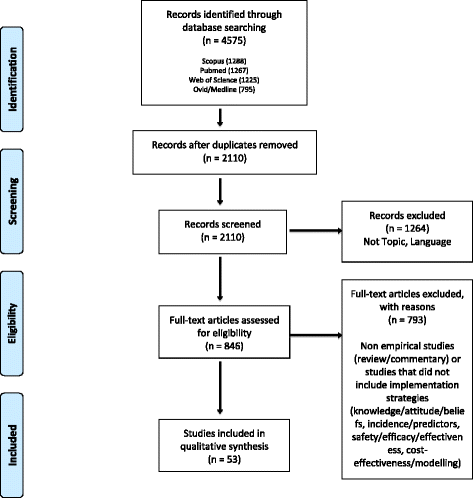Implementation strategies to improve cervical cancer prevention in sub-Saharan Africa: a systematic review
- PMID: 29426344
- PMCID: PMC5807829
- DOI: 10.1186/s13012-018-0718-9
Implementation strategies to improve cervical cancer prevention in sub-Saharan Africa: a systematic review
Abstract
Background: Developed countries, such as the USA, have achieved significant decreases in cervical cancer burden since the introduction of Pap smear-based programs in the 1960s. Due to implementation barriers and limited resources, many countries in sub-Saharan Africa (SSA) have been unable to attain such reductions. The purpose of this review is to evaluate implementation strategies used to improve the uptake and sustainability of cervical cancer prevention programs in SSA.
Methods: A reviewer (LJ) independently searched PubMed, Ovid/MEDLINE, Scopus, and Web of Science databases for relevant articles with the following search limits: English language, peer reviewed, and published between 1996 and 2017. The 4575 search results were screened for eligibility (CJ, LJ) to identify original research that empirically evaluated or tested implementation strategies to improve cervical cancer prevention in SSA. Fifty-three articles met criteria for inclusion in the final review. AA, CJ, and LJ abstracted the included articles for implementation-related content and evaluated them for risk of bias according to study design with the National Heart, Lung, and Blood Institute's (NHLBI) Quality Assessment Tools. Results were reported according to PRISMA guidelines.
Results: The 53 included studies are well represented among all sub-Saharan regions: South (n = 16, 30.2%), West (n = 16, 30.2%), East (n = 14, 26.4%), and Middle (n = 7, 13.2%). There are 34 cross-sectional studies (64.2%), 10 pre-posttests (18.9%), 8 randomized control trials (15.1%), and one nonrandomized control trial (1.9%). Most studies are "fair" quality (n = 22, 41.5%). Visual inspection with acetic acid (VIA) (n = 19, 35.8%) was used as the main prevention method more frequently than HPV DNA/mRNA testing (n = 15, 28.3%), Pap smear (n = 13, 24.5%), and HPV vaccine (n = 9, 17.0%). Effectiveness of strategies to improve program implementation was measured using implementation outcomes of penetration (n = 33, 62.3%), acceptability (n = 15, 28.3%), fidelity (n = 14, 26.4%), feasibility (n = 8, 15.1%), adoption (n = 6, 11.3%), sustainability (n = 2, 3.8%), and cost (n = 1, 1.9%). Education strategies (n = 38, 71.7%) were used most often but have shown limited effectiveness.
Conclusion: This systematic review highlights the need to diversify strategies that are used to improve implementation for cervical cancer prevention programs. While education is important, implementation science literature reveals that education is not as effective in generating change. There is a need for additional organizational support to further incentivize and sustain improvements in implementation.
Keywords: Cervical cancer; Implementation strategies; Prevention; Program implementation; Sub-Saharan Africa.
Conflict of interest statement
Ethics approval and consent to participate
Not applicable
Consent for publication
Not applicable
Competing interests
The authors declare that they have no competing interests.
Publisher’s Note
Springer Nature remains neutral with regard to jurisdictional claims in published maps and institutional affiliations.
Figures
Similar articles
-
Implementation strategies for infection prevention and control promotion for nurses in Sub-Saharan Africa: a systematic review.Implement Sci. 2019 Dec 30;14(1):111. doi: 10.1186/s13012-019-0958-3. Implement Sci. 2019. PMID: 31888673 Free PMC article.
-
Trials and projects on cervical cancer and human papillomavirus prevention in sub-Saharan Africa.Vaccine. 2013 Dec 29;31 Suppl 5:F53-9. doi: 10.1016/j.vaccine.2012.06.070. Vaccine. 2013. PMID: 24331748 Review.
-
Interventions to increase uptake of cervical screening in sub-Saharan Africa: a scoping review using the integrated behavioral model.BMC Public Health. 2020 May 11;20(1):654. doi: 10.1186/s12889-020-08777-4. BMC Public Health. 2020. PMID: 32393218 Free PMC article.
-
Infrastructure requirements for human papillomavirus vaccination and cervical cancer screening in sub-Saharan Africa.Vaccine. 2013 Dec 29;31 Suppl 5:F47-52. doi: 10.1016/j.vaccine.2012.06.066. Vaccine. 2013. PMID: 24331747 Review.
-
Integrated Review of Barriers to Cervical Cancer Screening in Sub-Saharan Africa.J Nurs Scholarsh. 2016 Sep;48(5):490-8. doi: 10.1111/jnu.12232. Epub 2016 Jul 19. J Nurs Scholarsh. 2016. PMID: 27434871 Review.
Cited by
-
Profiling the real-world management status of high-risk human papillomavirus infection: a protocol to establish a prospective cohort of high-risk human papillomavirus-infected women in Lueyang County, China.BMJ Open. 2022 Sep 19;12(9):e062678. doi: 10.1136/bmjopen-2022-062678. BMJ Open. 2022. PMID: 36123075 Free PMC article.
-
"When You Have Gotten Help, That Means You Were Strong": A Qualitative Study of Experiences in a "Screen and Treat" Program for Cervical Cancer Prevention in Malawi.J Cancer Educ. 2022 Apr;37(2):405-413. doi: 10.1007/s13187-020-01828-9. J Cancer Educ. 2022. PMID: 32737829 Free PMC article.
-
Development, acceptability and usability of culturally appropriate survivor narrative videos for breast cancer treatment in Botswana: a pilot study.BMJ Open. 2024 Jan 30;14(1):e073867. doi: 10.1136/bmjopen-2023-073867. BMJ Open. 2024. PMID: 38296302 Free PMC article.
-
Far behind 90-70-90's screening target: the prevalence and determinants of cervical cancer screening among Sub-Saharan African women: evidence from Demographic and Health Survey.BMC Cancer. 2024 Aug 26;24(1):1050. doi: 10.1186/s12885-024-12789-3. BMC Cancer. 2024. PMID: 39187776 Free PMC article.
-
'I'm here to save my life': a qualitative study of experiences navigating a cryotherapy referral system for human papillomavirus-positive women in western Kenya.BMJ Open. 2019 Jul 24;9(7):e028669. doi: 10.1136/bmjopen-2018-028669. BMJ Open. 2019. PMID: 31345973 Free PMC article. Clinical Trial.
References
-
- GLOBOCAN 2012: Estimated cancer incidence, mortality, and prevalence worldwide in 2012. http://globocan.iarc.fr/Default.aspx (2017). Accessed 27 Apr 2017.
-
- Lim JN, Ojo AA. Barriers to utilisation of cervical cancer screening in sub Sahara Africa: a systematic review. Eur J Cancer Care (Engl). 2017;26(1) 10.1111/ecc.12444. Epub 2016 Feb 7 - PubMed
Publication types
MeSH terms
Grants and funding
LinkOut - more resources
Full Text Sources
Other Literature Sources
Medical
Research Materials
Miscellaneous


